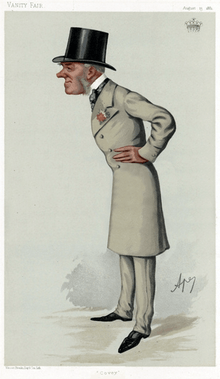George Coventry, 9th Earl of Coventry
| The Right Honourable The Earl of Coventry PC, DL | |
|---|---|
 Lord Coventry by Carlo Pellegrini, 1881. | |
| Captain of the Gentlemen-at-Arms | |
|
In office 28 May 1877 – 21 April 1880 | |
| Monarch | Victoria |
| Prime Minister | The Earl of Beaconsfield |
| Preceded by | The Earl of Shrewsbury |
| Succeeded by | The Earl Fife |
|
In office 6 July 1885 – 28 January 1886 | |
| Monarch | Victoria |
| Prime Minister | The Marquess of Salisbury |
| Preceded by | The Lord Carrington |
| Succeeded by | The Lord Sudeley |
| Personal details | |
| Born |
9 May 1838 Wilton Crescent, London |
| Died | 13 March 1930 (aged 91) |
| Nationality | British |
| Political party | Conservative |
| Spouse(s) | Lady Blanche Craven (d. 1930) |
| Alma mater | Christ Church, Oxford |
George William Coventry, 9th Earl of Coventry PC, DL (9 May 1838 – 13 March 1930), styled Viscount Deerhurst until 1843, was a British Conservative politician. He was Captain of the Gentlemen-at-Arms between 1877 and 1880 and again between 1885 and 1886 as well as Master of the Buckhounds between 1886 and 1892 and again between 1895 and 1901.
Background and education
Coventry was born at Wilton Crescent, London, the son of George William Coventry, Viscount Deerhurst, eldest son of George Coventry, 8th Earl of Coventry. His mother was Harriett Anne, daughter of Sir Charles Cockerell, 1st Baronet. He was educated at Eton and Christ Church, Oxford.[1]
Political career
Coventry sat on the Conservative benches in the House of Lords and served as Captain of the Honourable Corps of Gentlemen-at-Arms under the Earl of Beaconsfield from 1877 to 1880 and under Lord Salisbury from 1885 to 1886 and under Salisbury as Master of the Buckhounds from 1886 to 1892 and again from 1895 to 1900.[1] In 1877 he was admitted to the Privy Council. From 1921 until his death in 1930 he was Father of the House of Lords.
Coventry was also Lord Lieutenant of Worcestershire from 1891 to 1903,[1] and an Honorary Colonel of the 3rd and 4th (Militia) Battalions, the Worcestershire Regiment from 1900.[2] He was honoured as Lord High steward of Tewkesbury in December 1901,[3] and received the Honorary Freedom of the borough of Tewkesbury in January 1902.[4] During the First World War the Earl of Coventry, as Lord Lieutenant, was the figurehead of the county war effort. He chaired a number of committees and charities, and was President of the Worcestershire Volunteer Regiment (the WW1 Home Guard).[5] Apart from his political career he was also involved in horseracing. His racing colours were brown with blue cap and were carried to victory in consecutive Grand Nationals by the half sisters Emblem, 1863, and Emblematic, 1864.[6] In 1899 he was President of the Royal Agricultural Society.[1] The Earl was also interested in the development of agriculture and maintained a paternalistic attitude to his tenants. He established a jam factory in order to provide them with a local outlet for their fruit although this proved unable to compete with larger-scale commercial competitors and went into liquidation in 1908.[7]
Family
Lord Coventry married Lady Blanche, daughter of William Craven, 2nd Earl of Craven, on 25 January 1865. They had six sons and three daughters. He died on 13 March 1930, aged 91, and was succeeded in the earldom by his grandson George, the son of George William Coventry, Viscount Deerhurst. His second son the Hon. Charles Coventry was a soldier and successful cricketer.[8] Lady Coventry survived her husband by only three days and died on 16 March 1930, aged 87. His daughter, Lady Anne Coventry, was married to Prince Victor Duleep Singh, the eldest son of Maharaja Duleep Singh.[1]
References
- 1 2 3 4 5 thepeerage.com George William Coventry, 9th Earl of Coventry
- ↑ The London Gazette: no. 27154. p. 292. 16 January 1900.
- ↑ "Court Circular". The Times (36645). London. 23 December 1901. p. 7.
- ↑ "Court circular". The Times (36676). London. 28 January 1902. p. 7.
- ↑ Atkin, Susanne. "Croome Estate in WW1". Susanne Atkin Photography. Retrieved 2015. Check date values in:
|access-date=(help) - ↑ National horse racing museum profile
- ↑ Atkin, Susanne. "The Croome Jam Industry". Susanne Atkin Photography. Retrieved 2015. Check date values in:
|access-date=(help) - ↑ Atkin, Susanne (2016). "C.J. Coventry: Katia and Beyond". Friends of Croome Newsletter, No. 24.
External links
- Hansard 1803–2005: contributions in Parliament by the Earl of Coventry
| Political offices | ||
|---|---|---|
| Preceded by The Earl of Shrewsbury |
Captain of the Gentlemen-at-Arms 1877–1880 |
Succeeded by The Earl Fife |
| Preceded by The Lord Carrington |
Captain of the Gentlemen-at-Arms 1885–1886 |
Succeeded by The Lord Sudeley |
| Preceded by The Lord Suffield |
Master of the Buckhounds 1886–1892 |
Succeeded by The Lord Ribblesdale |
| Preceded by The Lord Ribblesdale |
Master of the Buckhounds 1895–1901 |
Succeeded by The Lord Chesham |
| Preceded by The Earl of Ducie |
Father of the House of Lords 1921–1930 |
Succeeded by The Viscount Hereford |
| Honorary titles | ||
| Preceded by The Earl Beauchamp |
Lord Lieutenant of Worcestershire 1891–1923 |
Succeeded by The Viscount Cobham |
| Peerage of England | ||
| Preceded by George Coventry |
Earl of Coventry 1843–1930 |
Succeeded by George Coventry |